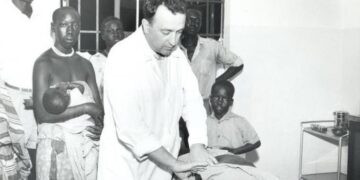BY FR. EDWARD KANYIKE MCCJ
It is common knowledge that in Africa procreation is one of the highest values and that one of the worst misfortunes an African couple or a woman in particular can ever have is sterility. Unlike in Western societies, in Africa, every adult woman can be called ‘mother’ without any risk of offending her. Moreover, the word for ‘madam’ in many African languages just means ‘mother’. ‘Nnyabo’ in many Ugandan Bantu languages literary means ‘mother of them’, ‘nnyina bo’ like ‘ssebo’ is a form of ‘ise bo’, ‘father of them’ and this ‘them’ represents society. One is either father or mother of society and as such he/she is respected.
The birth rites begin with pregnancy. That is, once the signs of pregnancy show up, precautions and taboos begin to be observed. There are exercises, medicines, alimentary taboos and observances, including periods of sexual abstinence, which an expectant mother has to carry out for the safety of the coming child and for her own wellbeing. This goes as far as avoiding some foods like eggs; mutton, pork, grasshoppers, garden crickets, fatty fish and chicken among other things. Childbirth comprises of three stages: separation, seclusion and aggregation or integration. The separation consists in the act of birth itself where the mother is surrounded by women only, where the baby comes out of the womb and with the first cry of the baby. It also consists in the cutting of the umbilical cord. Like in all rites of passage, separation is often dramatic and painful. The baby ceases to be in the womb and comes into the world. She/he will be carried on the back or on the side of the mother as “mwana wa bandi”, the child of others and not only of the mother.
The umbilical cord together with the placenta are well taken care of. The placenta is called the ‘other’ or the twin of the baby. It is put outside the house so that you have this duality: child in the house (baby) and child outside (placenta). When it is buried, you have: child on the ground (baby) and child underground (placenta). Since birth is death to the spiritual world represented by the womb, this death calls for a burial and it is the placenta that undergoes it. One is indeed buried either the very day one is born or soon afterwards. There are tribes which mark the place where the placenta of an individual was buried and he/she or the family carries out some rituals from time to time on that spot for his/her wellbeing.
Among the Baganda, when it dries and falls off the baby, it is kept for the day when the child will be initiated into the clan. It will be soaked into a basket of banana wine and its floating will be the sign that the child really belongs to the husband of the mother. The king’s umbilical cord is an institution in itself: it has a keeper and a house and it is used in rituals concerning the king and the queen mother.
The separation is followed by seclusion. The mother and her baby remain cut off from society for some days depending on the tribe and on the gender of the child. During this period, both mother and baby are bathed with special herbs. Prayers and sacrifices are also offered on their behalf and access to them is limited. This time calls for abstinence from sexual activities even on the part of a polygamous husband, in a number of tribes, until he resumes them ritually with the new mother. In some cultures of Malawi, this abstinence is symbolized by the presence of a mortar without a pestle near the bed of the new mother. In the house where there is a newborn baby, there is a fire which is the symbol of the life of the family and clan into which the baby has been born and on which the new life depends. Should the baby die while in seclusion, no proper funeral is carried out for him/her because he/she is not yet fully integrated into the family or clan. After seclusion comes integration or aggregation. It often coincides with the naming ceremony for the baby.
It is a feast. The baby is welcomed into the family and the clan. The mother resumes what we can call ‘normal life’. The baby and the mother are given gifts, the baby is dressed, exposed and is surrounded by women—-things that also take place at funerals. The baby becomes a social being with a name which indicate his/her clan, the ancestor partially re-incarnated in him/her, the circumstances of his/her birth or his/her social status if he/she is a special child. Although all African cultures have herbs which provoke abortion, traditional Africa practices it very rarely and often as a necessary evil. Pregnancy is a blessing as it is well spelt in Alur:mugisa, a blessing. It thus belongs to the couple, the family, the clan, the ancestors and finally, to the Creator. It is clear that in such a mentality, abortion is murder and it incurs the harshest punishment when proved.
















